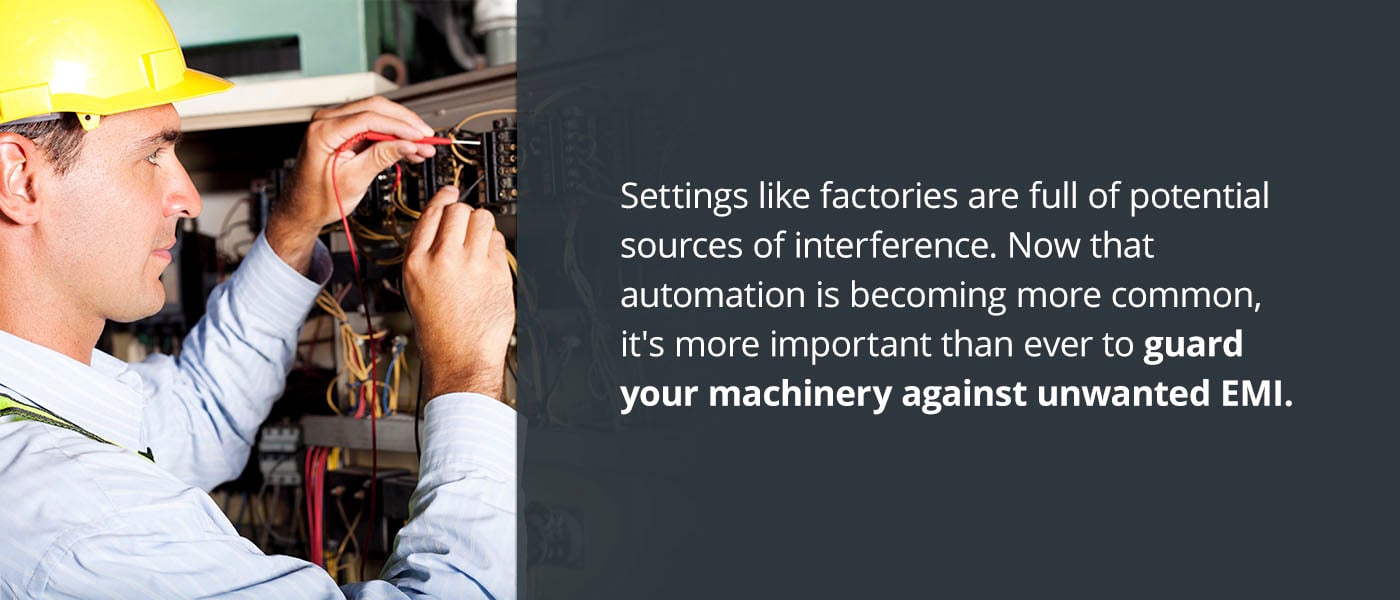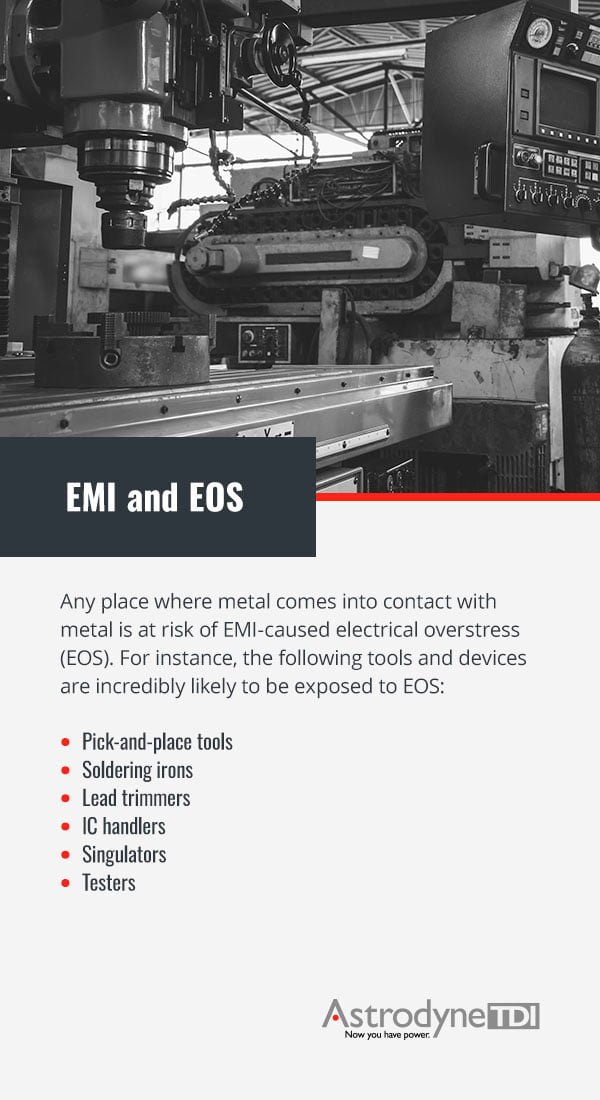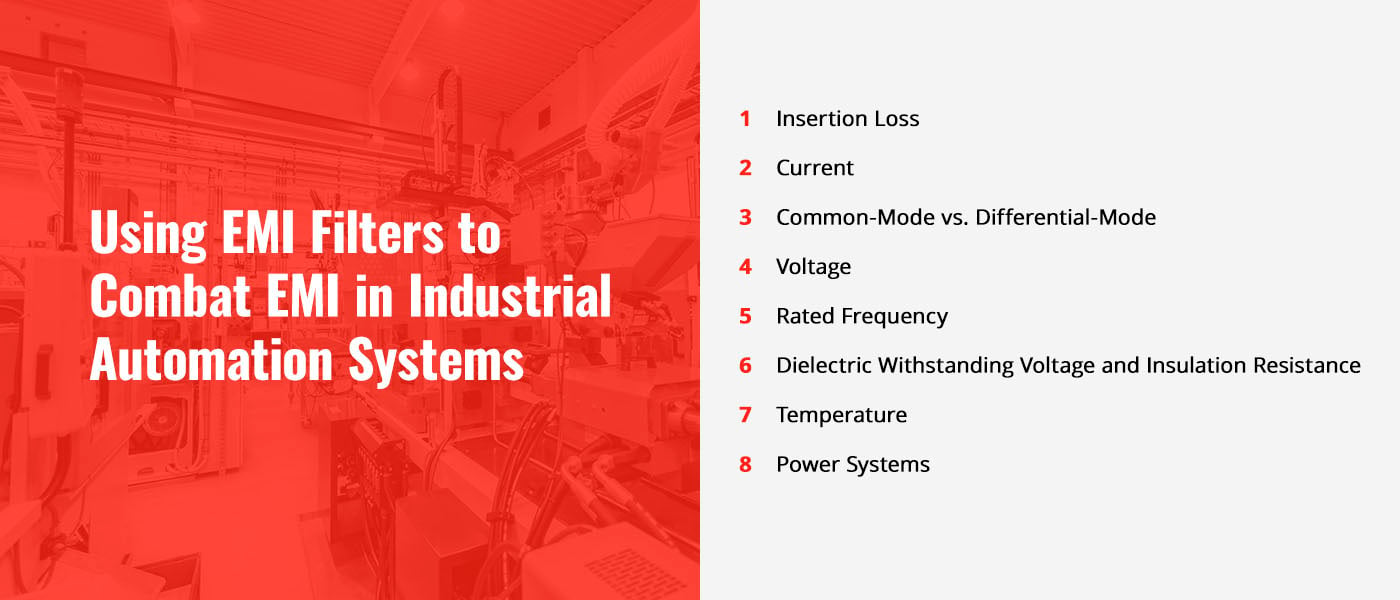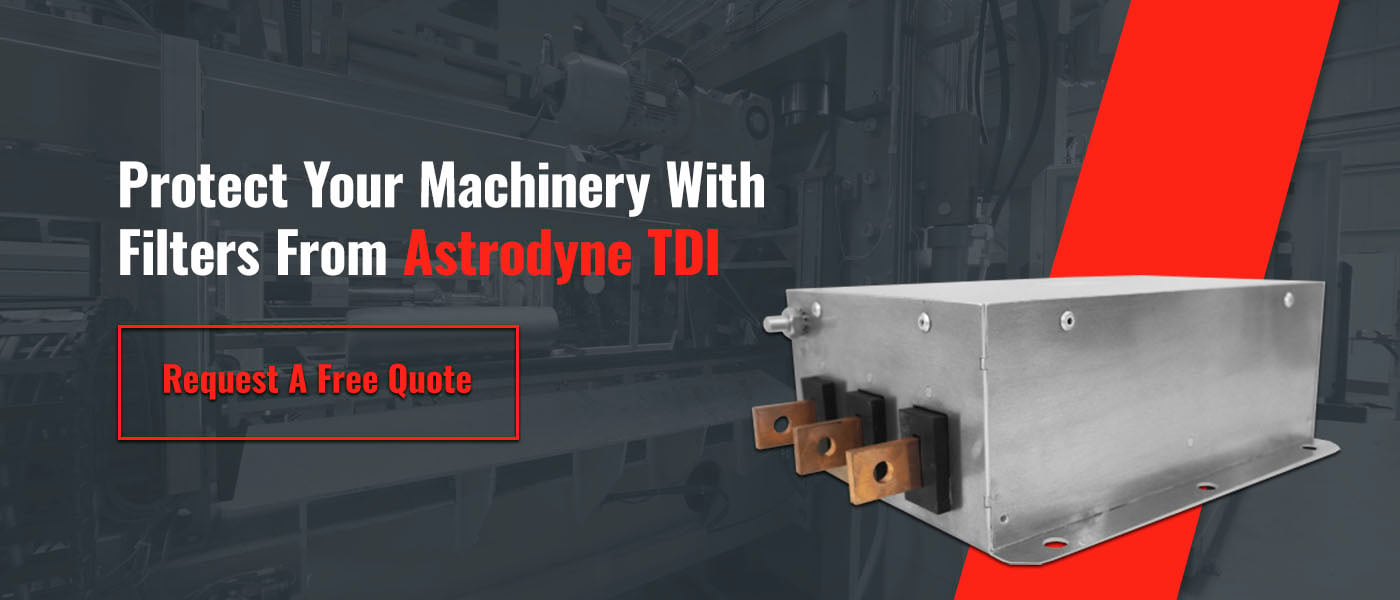RESOURCES
The Role of EMI Filters in Industrial Automation
As industrial automation becomes more digitized, the susceptibility of equipment to electromagnetic interference (EMI) increases. Filtering and/or shielding these devices against EMI is vital to ensure uninterrupted operation and intended output. This is especially critical because due to interference, controls can malfunction, resulting in faulty output. This can cause serious accidents and/or line-down conditions resulting in loss of productivity.
There are two existing types of electrical interference:
- Man-Made: This type of interference comes from man-made sources. These are typically narrowband and can be intentional (such as radio, television, cell phones) or unintentional (microwave, laundry machines, welders, etc.). This noise can propagate as conducted (over the wires) or radiated (through the air).
- Natural: This type of interference comes from atmospheric (static, lighting) or extra-terrestrial (solar, cosmic, interstellar). Solar storms and lightning are good examples of these.
In an industrial setting, machines operate close to each other making them vulnerable to interference. EMI filters can play a key role in preventing noise propagation and interruptions.

Electromagnetic Interference in Automated Industrial Settings
Settings like factories are full of potential sources of interference. Now that automation is becoming more common, it's more important than ever to protect machines against unwanted EMI. Common industrial sources of EMI include:
- Commutation: Turning the power on and off results in strong transients. The larger the load, the higher the transient levels, which can cause serious disruption. When the power on and off/switching happens at a high rate (such as microprocessor chips or commutator of a brush motor) the transients are generated repeated at a very high rate giving rise to high-frequency noise.
- Servo and Variable Frequency Drives (VFDs): These are the most common sources of noise in the industrial automation environment. These drives switch frequencies (typically between 8kHz and 20kHz ) to generate a pulse for regulating the motors. The edges of these pulses are only a few nanoseconds long. These can propagate through the entire system including the ground.
- Switched-Mode Power Supplies (SMPS): SMPS generate higher levels of EMI than linear power supplies. Switch-mode power supplies generate DC voltage from AC using high-frequency pulses (typically between 40KHz to 200kHz). These pulses have sharp edges resulting in a high amount of undesirable noise.
- Uninterruptable Power Supplies (UPS): In the situation of a power outage, UPS does DC to AC conversion. AC power supplied by the UPS is nowhere close to the true sine wave of the supply voltage. This looks more like a square wave with sharp edges. These edges coupled with the overriding noises generated during DC to AC conversion can result in significant high-frequency noise at the output.
- Dimmer Circuits: Triac-based dimmer switches generate periodic spikes synchronized with the line frequency resulting in high-frequency noise.
- Harmonics: Non-linear loads that do AC–DC conversion can cause high-frequency harmonics of the fundamental AC frequency. These harmonics can cause AC waveform distortion which is not good for the proper functioning of power electronics and machines. The odd harmonics are out of phase from the fundamental frequency causing serious system issues. Harmonics act like very low-frequency noise.
- Static Electricity: An electrostatic discharge (ESD) can induce a short duration voltage spike/pulse. This can be especially harmful to sensitive equipment, like microprocessor chips and other semiconductors or micro-electrical devices. This is an immunity issue.
Additional Sources of Electromagnetic Interference
While they aren't a source of EMI themselves, long wires can act as antennas and transmit EMI — the longer a wire is, the better an antenna it becomes for a wider frequency spectrum. When it comes into contact with noise, it'll transmit that signal through either conduction or parasitic capacitance.
Another source is noise coupling, which happens when the current moving through one wire induces a similar voltage on another parallel wire. Keep parallel wires apart by three or more inches to avoid noise coupling. When isolation is not possible, using shielded wires can help.

EMI and EOS
The EOS acronym refers to a failure state triggered by overwhelming heat, power, or current. One well-known cause of EOS is electrostatic discharge (ESD) — static electricity. However, EMI can also be a major contributor to EOS.
High-frequency noise is present in most modern-day automation and manufacturing tools such as robotic arms, automated fasteners, pick-and-place machines, lead trimmers, and wire bonders. This can be a significant source of EOS in industrial automation equipment. The presence of unwanted high-frequency noise in a production environment can cause potentially damaging exposure to sensitive devices.
The tools and equipment are generally protected against the foreseeable stresses due to line voltages, however, the impact of low amplitude high-frequency noise is often overlooked. At high frequencies, conductors behave differently. A straight wire becomes an inductor with noticeable impedance and a phase shift. While DC and 50/60Hz require a metal-to-metal contact for current flow, at higher frequencies currents can flow without a direct contact because of the low impedance path provided by the parasitic capacitance between conducting metals. This can give rise to unexpected current paths and phase shifts. The problem at high frequencies is compounded by the fact that the repetition rate is much higher due to the higher frequency of the noise signal.
Following tools and devices are highly likely to be exposed to EMI caused EOS:
- Pick-and-place tools
- Lead former and trimmers
- IC handlers
- Simulators
- Testers
- Wave solders
EOS is the leading cause of damage to integrated circuit (IC) components. An interrupted use of automation processes in operations greatly depends on the prevention and suppression of EMI within the facility. To minimize EOS, the origin and propagation of EMI within the tool/equipment, facility, and protective earth (ground) level must be fully evaluated, understood, and mitigated.
How Does EMI Cause EOS?
Many devices, such as servo drives and rotating machinery, consume high amounts of energy in short intervals, which causes high spikes in voltage. These peaks create high levels of EMI, which overwhelms nearby devices by interrupting their normal functions. These high-frequency interruptions can be especially damaging when they happen in close proximity to sensitive devices. If the voltage produced by the EMI is too high for the exposed devices to handle, they're at risk of EOS.
EOS is the leading cause of damage to integrated circuit (IC) components. If you use automation in your processes, the sustained daily function of your operation depends on your ability to prevent and suppress EMI within your facility. To minimize EOS as much as possible, you need to understand the origins of EMI on both a facility level and a ground level.
Consider which machines tend to generate the most noise and which parts of each machine cause internal interference. This information can help you to strategize the best method of implementing EMI-suppression equipment like filters.
Preventing EMI in Industrial Automation
Working to reduce the amount of EMI exposure for industrial machines is a smart move, especially now that wireless local-area networks (WLANs) are becoming more and more common in industrial facilities. When manufacturing an electric tool, you want to do more than filter out externally-created EMI — you also want to mitigate noise propagation within the device to prevent interference within itself.
Considering said factors in the early design phases typically allows for more cost-effective options moving forward. Here are a few design suggestions for reducing and preventing EMI in industrial automated technology:
- EMI Filters: EMI filters not only suppress unwanted conducted noise, but they can also help you comply with industrial EMI regulatory standards such as CISPR 11, EN61000-6-3, and EN61000-6-4.
- Shielding: This is a mechanical design technique of placing a grounded shield of magnetic or conductive material around the system. Shielding protects the system against radiated noise.
- Decoupling Capacitors: Placing capacitors close to the power pins on high-frequency ICs can help to reduce radiated EMI.
- Short Return Paths: A long, looping return path tends to act as a radiating antenna, resulting in EMI. By connecting the device grounds directly to the ground plane, you can significantly reduce interference levels.
Most of the time, it's difficult and expensive to go back and fix a vulnerable design or problematic machine in the field. EMI prevention is often a design afterthought, which makes fixing pre-existing machinery expensive and time-consuming. It is a good idea to do EMI due diligence upfront to avoid potentially more expensive field issues later.

Using EMI Filters to Combat EMI in Industrial Automation Systems
It's crucial to pick the right filter for your operation. After all, you want to make sure your filter can handle the demands of the device and will be enough to suppress the EMI down to acceptable levels. What filter do you need for your machinery?
Please read our Step-by-Step Process for Selecting An EMI Filterfor factory automation and other industrial systems.
Protect Your Machinery With Filters From Astrodyne TDI
Astrodyne TDI has over 60 years of experience in manufacturing top-notch EMI filters, so you can trust in the quality and performance of your products. If you know what you need, you can browse our online selection of EMI filters for off-the-shelf solutions.
If you need something a little more specific, or you want to know where to start — we can help! Astrodyne TDI offers custom solutions for specialized products. Get started by requesting a free quote or finding a representative near you to get more information on our products.


